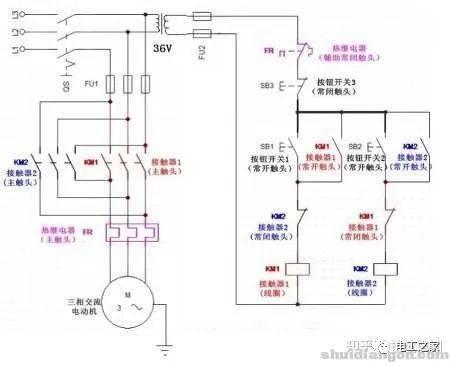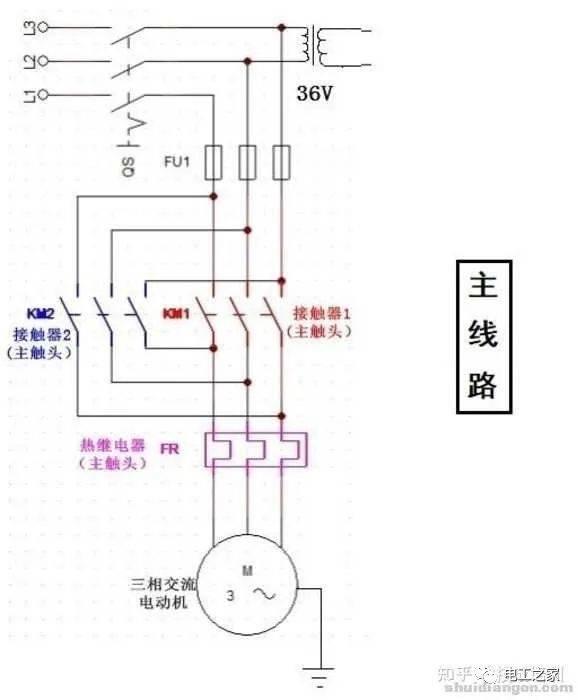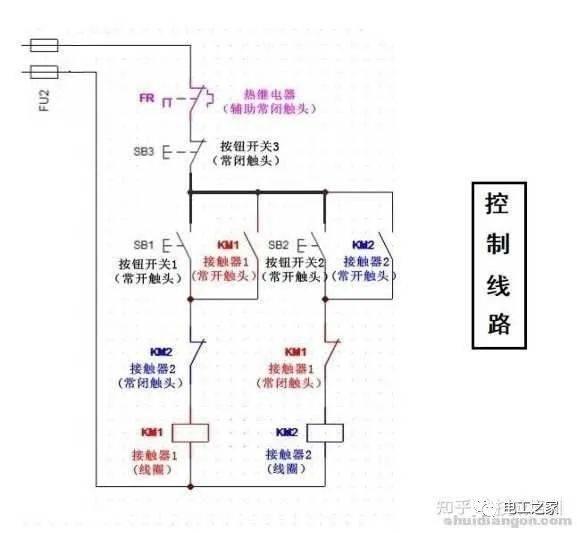-
Mail us
contact@tiger-transformer.com -
Phone us
(+86)15655168738
Mail us
contact@tiger-transformer.comPhone us
(+86)15655168738The application of motor forward and reverse is very extensive, and it is also one of the required items for the low-voltage electrician practical examination. Only when we fully understand its working principle and action process can we flexibly use it in practical work. And when a fault occurs, we can quickly troubleshoot the fault through principle analysis.
Working principle of forward and reverse rotation
If a three-phase asynchronous motor wants to realize forward and reverse rotation, it needs to find a way to exchange the three-phase power supply. Two phases. There are many ways to commutate, such as using transfer switches, contactors, etc. In practical applications, contactor commutation is generally used to achieve more forward and reverse rotation of the motor.
Let's take a look at the forward and reverse circuit diagram first, cut the circuit diagram from the middle, the left is the main circuit, and the right is the control circuit.

Main circuit principle
Let's take a look at the main line first. After the three-phase power supply passes through the fuse, it is divided into two circuits, which are respectively connected to the main contacts of the two contactors. At this time, the phase sequence of the contactor's main contact incoming line corresponds to the power supply one by one. The outgoing lines of the main contacts of the two contactors are exchanged and connected in parallel, then connected to the thermal relay, and finally connected to the motor.
When the main contact of KM1 is connected, power L1 flows to the first phase of the three-phase motor, power L2 flows to the second phase of the three-phase motor, power L3 flows to the third phase of the three-phase motor, and the motor rotates forward.
When the main contact of KM2 is connected, power L1 flows to the third phase of the three-phase motor, power L2 flows to the second phase of the three-phase motor, power L3 flows to the first phase of the three-phase motor, and the motor reverses.
So we only need to control the main contacts of contactor 1 and contactor 2 to make the motor rotate forward and reverse; if we want to control the main contacts of contactor 1 and 2, then we only need to control the main contacts of contactor 1 and 2. Need to control their coils. In addition, the main contacts of contactor 1 and 2 cannot be closed at the same time, otherwise the power supply will be short-circuited.

Control circuit principle
Single-phase 380V becomes 36V safe voltage after passing through the transformer, and then supplies power to the control circuit. After the 36V power supply first passes through the thermal relay and the stop switch SB3, it goes to the forward rotation button SB1, the reverse rotation button SB2 and KM1 normally open, KM2 normally open respectively.
If the forward rotation button SB1 is pressed, the current will reach the KM1 coil through SB1 and KM2 normally closed. At this time, the KM1 coil is energized, the KM1 main contact is connected, and the motor rotates forward. At the same time, KM1 is normally open to connect the two ends of SB1 to self-lock, and KM1 is normally closed to disconnect to prevent short circuit caused by mistakenly pressing the reverse button SB2.
If you press the stop button SB3, the KM1 coil will be de-energized, the KM1 main contact will be disconnected, and the motor will stop. At the same time, KM1 is normally open and disconnected and loses self-locking.
If the reverse button SB2 is pressed, the current will reach the KM2 coil through SB2 and KM1 normally closed. At this time, the KM2 coil is energized, the KM2 main contact is connected, and the motor reverses. At the same time, KM2 is normally open to connect the two ends of SB2 to self-lock, and KM2 is normally closed to disconnect to prevent short circuit caused by mistakenly pressing the reverse button SB1.
If you press the stop button SB3, the KM2 coil will be de-energized, the KM2 main contact will be disconnected, and the motor will stop. At the same time, KM2 is normally open and disconnected and loses self-locking.

Forward and reverse common faults
There is no response when pressing the forward and reverse buttons
If you press the forward and reverse buttons, the contactor does not respond (the contactor does not pull in) , that is, there is a problem with the control circuit. We want to focus on testing the control lines. First, check whether the control circuit has power, such as whether the safety transformer has output voltage and whether the control circuit fuse is broken; secondly, check whether the thermal relay and stop button are normal.
If the contactor is closed by pressing the forward and reverse buttons but the motor does not rotate, it means that there is no problem with the control circuit, but the problem with the main circuit. We should focus on checking the main line, such as whether the main line fuse is normal, whether the connection between the thermal relay and the motor terminal is normal.
In this case, the fault generally does not occur at the incoming and outgoing line of the contactor, because if there is a problem with a certain contactor and the other contactor is normal, then the fault in the outgoing line should only be forward or reverse rotation. The probability that the incoming and outgoing lines of the two contactors fail at the same time is very small. When troubleshooting, the possibility of a high probability of failure is generally checked first.
Press forward rotation and reverse rotation, the motor will run in one direction
This shows that there is no problem with the control circuit. The problem is that the two contactors can't pull together normally. The most likely reason for this failure phenomenon is that the power supply has no phase commutation or lack of phase. If the power supply does not have phase commutation, it will only run forward or reverse; if there is a lack of phase, it may only run forward or reverse, and it will be accompanied by the noise of the motor running unevenly.
Press the forward or reverse button, the contactor beeps
For this case, it is the contactor The closed connection is wrong, for example, the coil of KM1 is connected in series with the normally closed of KM1. In this way, as long as the KM1 coil is energized, the KM1 normally closed will be disconnected; since the KM1 coil and KM1 normally closed are connected in series, once KM1 normally closed is disconnected, the coil will be powered off, and KM1 normally closed will return to the connected state. ;Once the KM1 normally closed is connected, the coil will be energized again, then the KM1 normally closed will be disconnected again...and then repeat this state, so there will be pull-off-pulse-off The phenomenon.
So when we are wiring, we must connect the normally closed of the KM1 contactor in series to the KM2 coil, and connect the normally closed of the KM2 contactor in series to the KM1 coil.
Press forward to turn normally, press reverse without any response
Forward turns normally, reverse does not respond, indicating that the forward turn is the main There is no problem with the wiring and control wiring, and the problem is the inversion. If the reverse does not respond (the contactor does not pull in), it means that there is a problem with the control circuit (because the control circuit is fine, the contactor will pull in). Therefore, it is necessary to focus on checking the reverse loop, that is, the SB2 loop.
When the motor is rotating forward, press reverse accidentally, the switch trips
When the motor is rotating forward, press reverse, the switch trips, This indicates a short circuit in the line. Then we have to focus on the interlock, that is, whether the normally closed KM1 and KM2 are connected in series to the other coil.